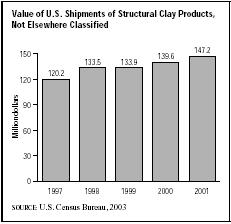SIC 3259
STRUCTURAL CLAY PRODUCTS, NOT ELSEWHERE CLASSIFIED
This industry classification includes establishments engaged in the manufacture of clay sewer pipe and structural clay products, not elsewhere classified. Other products include adobe brick, clay chimney pipe, clay drain tile, and clay roofing.
NAICS Code(s)
327123 (Other Structural Clay Product Manufacturing)
Although this small industry's shipments increased regularly in current dollar value during the 1980s, by the mid-1990s both its shipments and employment were declining. The industry shipped $150.4 million worth of goods and employed 1,800 workers in 1995, which marked a 14 percent decline, not including inflation, since the industry's 1989 peak of $175 million in shipments. After declining to $120.2 million in 1997, the value of shipments began to increase throughout the 1990s. In fact, shipments grew each year between 1997 and 2001. Between 2000 and 2001, they rose from $139.6 million to $147.2 million. Employment also increased from 1,332 in 1997 to 1,473 in 2000.
Once the largest segment of this industry, vitrified clay sewage pipe and fittings accounted for only 35 percent of the value of total industry shipments in 2001. Between 1997 and 2001, vitrified clay sewage pipe and fitting shipments increased modestly, growing from $46.5 million to $51.2 million. However, shipments in 2001 actually reflected a decline from the $51.5 million worth of good shipped in 2000. Less than 10 companies manufactured clay sewer pipes in the early 2000s, and an estimated total of 50 establishments comprised the whole industry.
During the mid-1990s, other structural clay products such as architectural terra cotta, drain tile, flue tile, roofing tile, and conduit had become the industry's leading segment, accounting for 53 percent of industry shipments by 1997. Fueled by a booming construction industry, demand for these products had climbed steadily throughout the late 1990s and early 2000s. By 2001, this sector accounted for 63 percent of total industry shipments. The

value of industry shipments jumped from $63.9 million in 1997 to $92.9 million in 2001.
Total employment fell from 2,200 workers in 1988 to 1,800 workers in 1995 to 1,332 workers in 1997; production workers totaled 1,025 for 1997. In 2000, industry employment had rebounded slightly to 1,473 workers, of whom 1,033 were production workers. The average wage in the industry, $12.92 per hour in 2000, was lower than the U.S. average for manufacturing wages, but it was nearly equal to the average for all structural clay production combined. The industry was regionally concentrated in the early 2000s, with California and Ohio accounting for roughly two-thirds of the industry's employment.
Some industry observers expected significant downsizing to continue in this industry during the early 2000s. The only occupations expected to increase employment levels include extruding and forming machine operators, industrial machinery mechanics, sales workers, maintenance repairers, truck drivers, industrial production managers, and coating machine operators. Those occupations expected to face reductions are primarily in the realm of assembly/production and include assemblers, furnace operators, crushing and mixing machine operators, inspectors, hand packers, packaging machine operators, machine feeders, material movers, secretaries, cutting machine operators, general machine operators, grinders, and machine forming and machine tool cutting operators.
The top firm in this industry at the turn of the twenty-first century was A & M Products Inc., of Danbury, Connecticut, with estimated sales of $150 million. Next were KMG Minerals of Kings Mountain, North Carolina, and U.S. Tile Company of Corona, California, both with sales of roughly $15 million.
Further Reading
U.S. Census Bureau. "Statistics for Industry Groups and Industries: 2000." February 2002. Available from http://www.census.gov/prod/2002pubs/m00as-1.pdf .
——. "Value of Shipments for Product Classes: 2001 and Earlier Years." December 2002. Available from http://www.census.gov/prod/2003pubs/m01as-2.pdf .
Comment about this article, ask questions, or add new information about this topic: